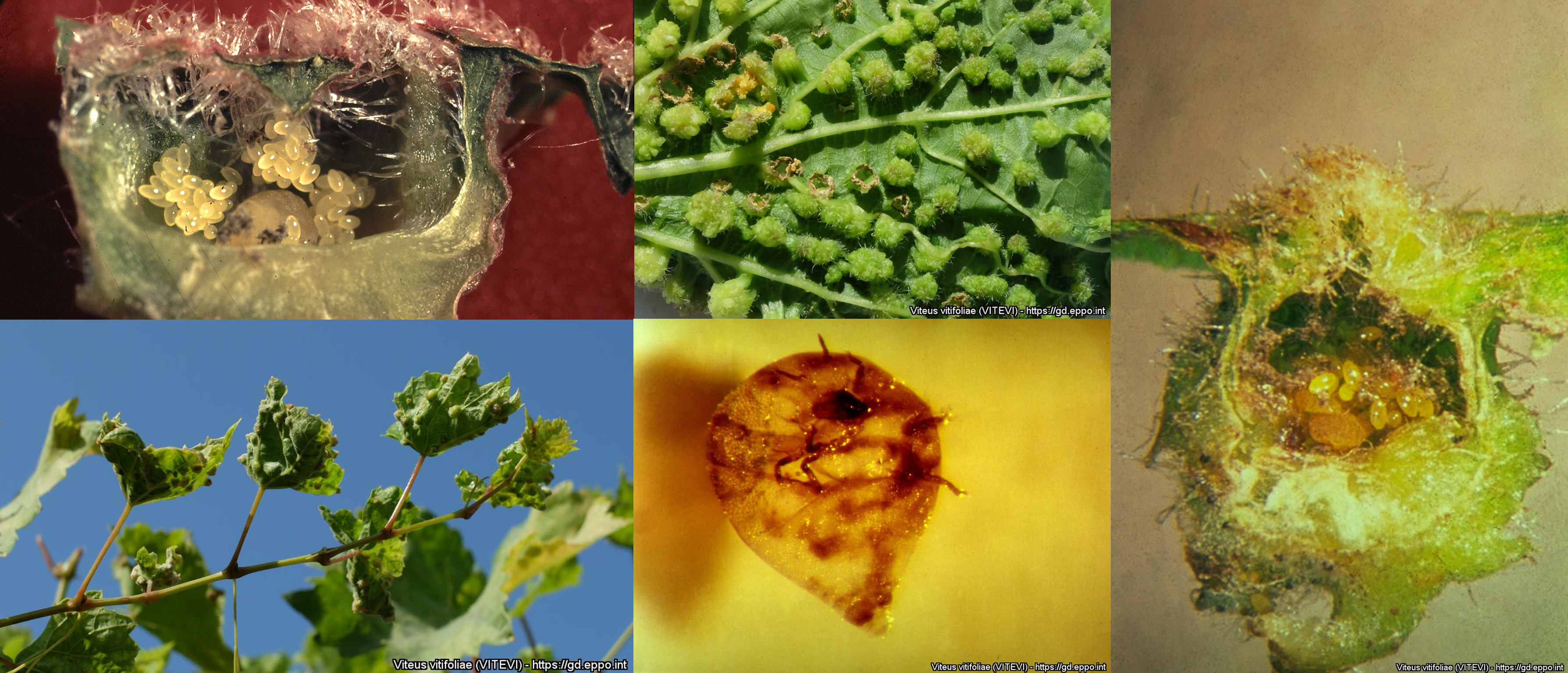Phylloxera is the popular name for Daktulosphaira vitifoliae - a quarantine pest organism of grapevines. It attacks both cultivated and wild varieties, with European varieties being the most susceptible. The pest stings and sucks sap from roots and rootlets. As a result of the attack, deformations called nodosities or tuberosities (swellings) appear. Nodosities form on thicker roots, tissues crack, allowing various fungi and bacteria to penetrate, leading to decay. Infested plants have yellow leaves, cease development and bear little fruit, and within 3-6 years, the vine withers.
Phylloxera has several morphological forms:
- gall-forming form: apterous, 1.5-2 mm long, with two subtypes: fundatrix or stem mother, with a pear-shaped body, and fundatrigenic with a globular body and narrow apical abdomen, yellow-orange (fig. 1)
- root-forming form: apterous, with an oval body, varying in color from yellow-reddish to brown-chestnut. It has 70 small tubercles situated dorsally that can secrete a white waxy substance covering the insect's body
- winged (sexual) form: elongated body, about 1 mm long, yellow-orange in color, long transparent wings, well-developed antennae.
- sexual form: emerges from winter eggs (resistant form) with an elliptical shape, yellow when laid, then turning brown, laid by the winged form.
Phylloxera - Attack Symptoms
The attack is particularly evident on clayey soils, where cracks form through which the pest migrates from the roots of one vine to another. The gall-forming form attacks the tips of shoots by piercing, resulting in hypertrophy of the tissue and the formation of galls on the upper side of the leaves (fig. 2), and on the upper side, there are small openings where the larvae leave the gall.
Additionally, the attacked shoots cease growth, and the wood does not mature. The root-forming form attacks the roots by piercing and sucking, causing tissue deformations, hypertrophy, nodosities, and tuberosities, and within 3-6 years, the vine withers.

How to Prevent Damages?
As a result of the widespread grafting of European grapevines onto American rootstocks, the damage caused is limited to gall formation on the leaves of the rootstocks. In the case of the damage caused by the root-forming form, it occurs in plantations where European grapevines are still cultivated on their own roots.
Species Biology - Polyvoltine: It has two biological cycles: a complete one, with all morphological forms occurring only on American grapevines and some direct-producing hybrids, and an incomplete one on European and Asian grapevine varieties, developing only on the roots.
From the winter egg, deposited in autumn under the bark, the stem mother emerges in spring, in April, which attaches to leaves of American vines or direct-producing hybrids, where it forms galls on the lower side of the leaves. It deposits about 600 eggs in the galls, and after 3-5 days, the larvae hatch, which, in turn, produce galls, succeeding up to 4-5 generations of gall-forming forms. Some of them descend to the roots, where they multiply parthenogenetically, giving rise to root-forming forms. In August, some of these give rise to winged (sexual) forms, which emerge from the soil, fly and deposit two types of eggs on vines, some small-sized eggs from which males emerge, and larger ones from which females emerge. After mating, the females deposit one egg each under the bark, where they overwinter. The other larvae continue to develop and multiply parthenogenetically, giving rise to root-forming forms, which overwinter in the larval stage.
Phylloxera - Prevention and Control
Preventive Measures
- grafting European grapevine varieties onto American rootstocks (Vitis riparia, Vitis rupestris, Vitis berlandieri)
- cultivation of resistant or tolerant varieties and hybrids
- use of controlled viticultural planting material, free from phylloxera
Curative Measures
- biological methods: the root-forming form is attacked by mites, Carabidae, Coccinellidae, and Staphylinidae, while the gall-forming form is attacked by mites (Trombidiidae), lacewings (Chrysopidae), thrips (Scolothrips acariphagus), bugs (Anthocoridae), beetles (Coccinellidae); in addition to predators, the fungus Beauveria bassiana can be used.
- cultural methods: flooding the vineyards for a few weeks can reduce population levels.
- mechanical methods: collection of primary gall leaves and their destruction (in small plantations) during the egg-laying period by the stem mother.
- physical methods: short-duration hot water treatments of rooted cuttings
IMPORTANT! Phylloxera is the most dangerous pest of grapevines. In rootstock plantations, the pest's attack reduces the quality of the rootstocks, resulting in a 10-22% decrease in rootstock cuttings' production. The multiplication of the pest is favored by viticulture on clayey and loamy-sandy soils and disadvantaged on sandy soils. The most effective method of control remains grafting European varieties onto American vines.
Article sourced from agromedia.md
